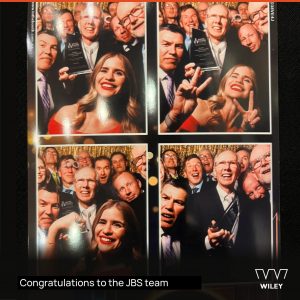
- Industry Type: Industrial Manufacturing, Food Processing, Distribution
- Author: Andrew Newby
- Service Area: Advice
- Date: 04 Jul 2012
Wiley joined a group of food industry leaders on the Gold Coast for two days of intense knowledge sharing at the 2012 Australian Food and Grocery Council (AFGC) Highlands Conference.
With all facets of the Australian food sector represented, this year’s theme of Growth in a Challenging Economy was addressed with purpose and insight. The diverse selection of speakers and content created the basis for a range of great conversations. Considering this year’s topics and the implications they present for everyone concerned the term ‘challenging’ doesn’t quite cover it. The backdrop of the Australian food industry is shifting entirely. People come first, they are empowered to care, their phones are a loud and legitimate voice and this level of instant evangelism is changing everything!
What struck me most about the overall message here was the sheer magnitude of change our food industry now faces.
THE BACKDROP
Chris Richardson of Deloitte Access Economics told us that while the food industry is the best performing sector outside of metal products, output is just ahead of where it was 4 years ago. The model that has served us for sixty years is breaking down and as Joanne Denney-Finch of the Institute of Grocery Distribution (IGD) put it—there are winds of change.
These winds are strong and the change is such that we need to be prepared to be blown off course or go down with the ship. Stimulating growth and making it durable for the long term requires a united industry approach and companies to rise to the challenge and make the most of it.
The strong winds Joanne spoke about are the rise of the new superpowers, the great economic correction, a battle for resources, our volatile climate, the demographic time bomb and the pace of science and technology.
Are there any sectors of industry that will escape the impact of any of these factors?
THE SHIFT
As stormy as these winds are, Joanne’s answer to the challenge was both eloquent and full of possibility. The potential, she said, is breathtaking if we build the right platform.
She cited technology as a powerful new building block employing new fuels, materials and more reliable, open farming techniques. Processing lines which can harvest and convert waste. Sensors providing live feedback to consumers. Changing the experience of shopping with tablets mounted on shopping trolleys.
The real challenge is in finding these opportunities.
Get closer to consumers—the consumer is now in the driving seat and an intimate relationship is paramount to foodies. Shopper’s attitudes and behaviours are evolving at an accelerated rate. They are more informed, ethical, skeptical, questioning and technology is changing the way we relate, driving real transparency. Smart phones have changed everything. Food manufacturers must innovate, customise and personalise. One of her examples is highly-tailored and personalised nutrition delivered directly to your door.
Josie Brown, Director of Digital, JWT Melbourne presented on sensible and productive ways to use digital media and smart phones to strengthen an intimate connection with the consumer. Content should be helpful, fun or saving time or money.
Standards of ethics and transparency—the industry was asked to keep raising the standards of ethics and transparency and “turn the tide of scrutiny to our advantage”. The prime example of this was to embrace the trend of fully traceable food.
Strong partnerships—build multiple bridges across all levels of industry, horizontally, vertically, in the supply chain, with your consumers, and with your competitors. Alliances can be a route to growth. Joanne’s advice was there is no shortage of other things to compete over—collaborate and share progress.
Resource use—deliver step changes in the use of resources and spread best practice. Design out resources and crack down on waste, especially waste in the chain and preventing it at its source.
Develop people—everything hinges on the skills and dedication of people. Attract the brightest and best, develop them and encourage collaboration.
SUSTAINABILITY
AFGC launched their sustainability commitment which is about balancing economic growth and social needs with the natural environment. It is a similar model to that currently in use in Europe and you can find the targets to reduce the industry’s footprint on the AFGC website (www.afgc.org.au).
The first focus is environmental – reducing water, waste, carbon use, energy and improving packaging and sourcing. They stated it is time for a coordinated and consistent message and we must lead the sustainability effort or it will lead us. It was encouraging to note that half the delegates put their hand up when asked if they were implementing a sustainability plan!

Mella Frewen, Director-General of Food Drink Europe spoke on Europe’s roadmap to confidence, competitiveness and sustainability and asked those gathered, where do you start and stop? Why is carbon the measure?
She suggested a broader approach where all interactions across the entire food chain and lifecycle are considered and measured. Most of the impact is at the farm or at the table, and consumers are interested beyond soil to the quality of the seed.
The IGD website (www.igd.com) has some great examples of companies around the world innovating in the areas of sustainability.
RETAIL
Woolworths and Coles both gave very interesting presentations, in confidence, about their future plans in an extremely promiscuous retail market. Their focus is clearly aligned with what we have outlined in this article. Costco also presented their value and scale model and the huge opportunity that exists to expand locally.
Tristan Harris of Harris Farms, a small, family owned fresh food market stated the key to his competing with the big guys is flexibility and agility.
Braedon Lord of Aussie Farmers Direct talked about “reinventing the milkman”. He stated the key to their success is a focus on total convenience, sustainability, a just-in-time model and a strong link to the community.
THE CRUNCHED NUMBERS
Chris Richardson from Deloitte Access Economics spoke on the challenges of the multi-speed economy and the outlook for retail demand. He says the worst is over but have two plans – one in case Europe blows a tyre.
Food demand is swinging towards protein, and considering 2/3 of the world’s middle class will soon live in China the opportunity is who gets to supply that demand? Our productivity level peaked a decade ago and we need in invest in plant and equipment to make the most of this opportunity.
IBM launched their study on today's empowered consumer. The power that was once with the manufacturer is now held by the consumer. The rate of change of technology is changing the eco-system we operate in and foodies need to truly engage customers as individuals to create trust in their brand.

They called it the age of the consumer. They stated trust is driven by clear comprehensive and concise communication. Chris Percy from Nielsen Pacific says the lever to more sales is more product choice; more touch points, and a better connection. In Australia, despite a stronger economic position than most nations, retail spending is slowing and we are more frugal than ever.
Ben Gilbert of UBS discussed profitability of our retailers in the face of many industry commentators referring to Australia as “Treasure Island”. He stated that loyalty programs would be the next big battleground.
As always, there were some great case studies. Our friends at Foodbank spoke about their exciting end hunger launch, and their partnership cookbook!
All the facts and figures were crunched and AFGC members can download these presentations from the member's area of their website (www.afgc.org.au).
SETTING A COURSE FOR GROWTH
Challenges ahoy! Spending is down and costs continue to increase and more and more empathetic, conscious and informed consumers armed with smartphones are sliding over into the driver’s seat and taking the wheel.
How will you hoist your mainsail to navigate these wild winds of change? One of the manufacturers I spoke to remarked that their biggest challenge was striking the balance between developing new consumer savvy products while managing the potential risk of phasing out of their traditional hallmark products.
This may ring true for many food brands and the retailers that sell them as they attempt to reinvent themselves to connect to this new, fully transparent marketplace.
The way ahead is indeed challenging, yet if we can embrace the necessary changes the reward is opportunity for continued and sustainable growth.
Thanks again to John, Geoffrey, the board, David, Cynthia and the whole crew at AFGC for another excellent Highlands!
About the author
Andrew Newby is the Business Development Director at Wiley and can be contacted on 1300 385 988 or email connect@wiley.com.au
Download to read full article
To read this document you will need Adobe Reader




